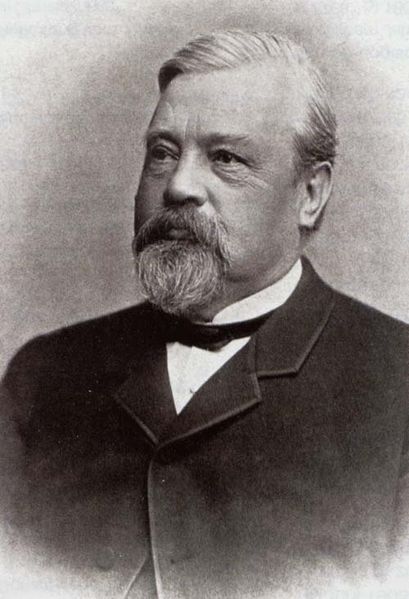<Back to Index>
- Anatomist Karl Gegenbaur, 1826
- Composer Otto Moritz David Goldschmidt, 1829
- King of the United Kingdom William IV, 1765
PAGE SPONSOR

Karl Gegenbaur (21 August 1826 - 14 June 1903) was a German anatomist and professor who demonstrated that the field of comparative anatomy offers important evidence supporting of the theory of evolution. As a professor of anatomy at the University of Jena (1855 – 1873) and at the University of Heidelberg (1873 – 1903), Carl Gegenbaur was a strong supporter of Charles Darwin's theory of organic evolution, having taught and worked, beginning in 1858, with Ernst Haeckel, 8 years his junior.
Gegenbaur's book Grundzüge der vergleichenden Anatomie (1859; Elements of Comparative Anatomy) became the standard textbook, at the time, of evolutionary morphology, emphasizing that structural similarities among various animals provide clues to their evolutionary history. Carl Gegenbaur noted that the most reliable clue to evolutionary history is homology, the comparison of anatomical parts which have a common evolutionary origin. Gegenbaur had been a student of Albert von Kölliker, Rudolf Virchow, Heinrich Müller and Franz Leydig (1821 – 1908).
Carl Gegenbaur was born in Würzburg, Bavaria, in 1826, and he entered the University of Würzburg as a student in 1845. After taking his degree in 1851, he spent some time in travelling in Italy and Sicily, before returning to Wurzburg as Privatdozent in 1854. In 1855, he was appointed extraordinary professor of anatomy at the University of Jena, and in 1858, he became the ordinary professor, where after 1865, his former student and fellow worker Ernst Haeckel was professor of zoology. In 1873, Carl Gegenbaur was appointed to Heidelberg, where he was professor of anatomy and director of the Anatomical
Institute until his retirement in 1901. He died on 14 June 1903, at Heidelberg. The work by which Gegenbaur is best known is his Grundriss der vergleichenden Anatomie (Leipzig, 1874; 2nd edition, 1878), translated into English by W.F. Jeffrey Bell (as Elements of Comparative Anatomy, 1878), with additions by E. Ray Lankester. While recognizing the importance of comparative embryology in the study of descent, Gegenbaur laid stress on the higher value of comparative anatomy as
the basis of the study of homologies, i.e., of the relations between
corresponding parts in different animals, as, for example, the arm of
man, with the foreleg of a horse, and with the wing of a fowl. A
distinctive piece of work was effected by him in 1871 in supplementing
the evidence adduced by Huxley in refutation of the skull-vertebrae theory: the theory of the origin of the skull from expanded vertebrae, which, formulated independently by Goethe and Oken, had been championed by Owen. Huxley demonstrated
that the skull is built up of cartilaginous pieces; Gegenbaur showed
that in the lowest (gristly) fishes, where hints of the original
vertebrae might be most expected, the skull is an unsegmented gristly
brain-box, and that in higher forms, the vertebral nature of the skull
cannot be maintained, since many of the bones, notably those along the
top of the skull, arise in the skin. In 1858, the physician Ernst Haeckel studied under Carl Gegenbaur at Jena, receiving a doctorate in zoology (after his medical degree), and became a professor at the same institution, the University of Jena. Ernst Haeckel expanded on the ideas of Gegenbaur while advocating the concepts of Charles Darwin. In 1861, he published "Ueber den Bau und die Entwickelung der Wirbelthier-Eier mit partielleer Dotterbildung" ("Proof that the ovum is unicellular in all vertebrates", Arch. Anat. Phys., 1861.8: 461-529), a fundamental proof in embryology. Gegenbaur learned techniques as a student of Albert von Kölliker, Rudolf Virchow, Heinrich Müller and Franz Leydig (1821 – 1908). Carl Gegenbaur had a strong influence on his environment, with his colleagues Matthias Jakob Schleiden, Emil Huschke, Ernst Haeckel, and Hermann Klaatsch (1863 – 1916). Carl Gegenbaur also influenced his students, including: Max Fürbringer, Richard Hertwig, Oskar Hertwig, Emil Rosenberg, Ambrosius Hubrecht, Johan Erik Vesti Boas (1855 – 1935), Hans Friedrich Gadow, M. Sagemehl, N. Goronowitsch, H.K. Corning, C. Röse and S. Paulli. Gegenbaur's
research program of comparative morphology incorporating ontogeny and
phylogeny is still evident in the burgeoning field of evolutionary
developmental biology (evo-devo).
Other publications by Carl Gegenbaur include a Textbook of Human Anatomy (Leipzig, 1883, new ed. 1903), the Epiglottis (1892) and Comparative Anatomy of the Vertebrates in relation to the Invertebrates (Leipzig, 2 vols., 1898 – 1901). In 1875, he founded the Morphologisches Jahrbuch ("Morphological Yearbook"), which he edited for many years. In 1901 he published a short autobiography under the title Erlebtes und Erstrebtes (German "experiencing and striving").